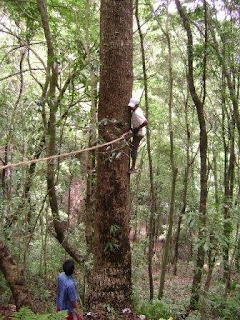In Kathmandu there are worse places to hang out than in Jana Bahā, majestic home to one of the Valley’s four famed Lokeśvaras. Like many icons of the Valley, it is sacred not only to Newar Buddhists, who control the ritual and institutional complex connected with the deity, but also for Tibetans (as Jo bo dzam gling dkar mo) and a sizeable number of non-Buddhists (in the guise of ‘White Matsyendranātha’).
 It so happens that tomorrow is an important day in the ongoing renovation of Jana Bahā. Formally this began with expeditions to the nearest forest (vanayātrā) to seek suitable lumber, much along the lines prescribed in Kuladatta’s Kriyāsaṃgraha (itself almost certainly a Newar composition). As almost the entire Valley has been deforested these days, the builders’ Getting of Wood took place on the mountains on the Valley’s rim. Nevertheless, chronicles record that timber was also scarce in the not-too-distant past; it would take several weeks or months to drag the chosen log(s) to their destination in the city.
It so happens that tomorrow is an important day in the ongoing renovation of Jana Bahā. Formally this began with expeditions to the nearest forest (vanayātrā) to seek suitable lumber, much along the lines prescribed in Kuladatta’s Kriyāsaṃgraha (itself almost certainly a Newar composition). As almost the entire Valley has been deforested these days, the builders’ Getting of Wood took place on the mountains on the Valley’s rim. Nevertheless, chronicles record that timber was also scarce in the not-too-distant past; it would take several weeks or months to drag the chosen log(s) to their destination in the city.
What makes this renovation qualitatively different from its many predecessors in the Newar tradition is a new level of transparency. The organizers have taken the startling but commendable step of documenting much of the process online, in English, at janabahaa.blogspot.com.

